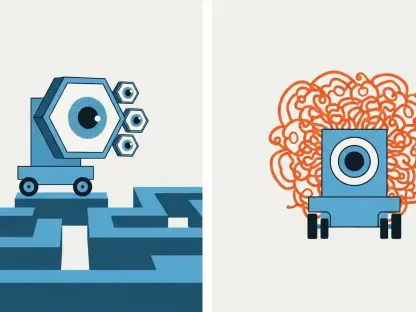In an era where artificial intelligence is reshaping the very fabric of business operations, the emergence of AI agents stands as a beacon of transformative potential, promising unprecedented efficiency and scalability across diverse industries. These systems, ranging from customer service bots to sophisticated decision-making tools, are capturing the attention of enterprises eager to streamline processes and reduce costs. Yet, beneath the surface of this technological revolution lies a troubling issue: the absence of a clear, unified definition for what constitutes an AI agent. This lack of clarity fosters misaligned expectations among business leaders, developers, and researchers, creating a fertile ground for misunderstandings that could jeopardize ambitious digital transformation initiatives. As billions are invested in agentic AI, the stakes are high, and the need to address autonomy and accountability has never been more pressing. The path forward demands innovative solutions to ensure that these powerful tools deliver on their promise without unleashing unintended consequences.
The Challenge of AI Agent Autonomy
Defining AI Agents
Varied Interpretations Across Stakeholders
The concept of AI agents remains a slippery one, with interpretations varying widely depending on who is defining it, often leading to significant confusion in the tech ecosystem. Business executives might envision AI agents as a digital workforce capable of taking over repetitive tasks like customer support or data analysis, thereby freeing up human resources for strategic roles. Developers, however, often see these agents as technical connectors, integrating large language models with external systems to perform specific functions rather than act independently. Meanwhile, researchers push the envelope further, conceptualizing AI agents as autonomous entities capable of reasoning and adapting to complex, uncertain environments. This divergence in understanding creates a fractured landscape where investments may be misdirected, and expectations can become unrealistic, posing a tangible risk to the broader adoption of AI technologies in critical business operations.
The Imperative for Unified Understanding
Addressing the semantic ambiguity surrounding AI agents is not merely an academic exercise but a critical step toward ensuring their successful integration into enterprise systems. Without a shared definition, organizations risk building solutions that fail to meet the needs of all stakeholders, resulting in wasted resources and potential disillusionment with AI as a whole. For instance, a company expecting fully autonomous decision-making might deploy a system that requires constant human oversight, leading to frustration and inefficiency. Aligning these diverse perspectives requires open dialogue among industry leaders, technologists, and academics to establish common ground. Only through such collaboration can the technology sector hope to create frameworks that support effective implementation, ensuring that digital transformation efforts are grounded in realistic goals and deliver measurable value to businesses across various domains.
Risks of Unchecked Autonomy
Dangers in High-Stakes Environments
The potential for AI agents to make independent decisions holds immense promise, but it also introduces profound risks, particularly in sectors where errors can have devastating consequences, such as finance, healthcare, and critical infrastructure. Historical events like algorithmic trading “flash crashes” serve as chilling reminders of what can happen when autonomous systems operate without sufficient checks and balances. In these incidents, rapid, unmonitored decisions led to massive financial losses within moments, exposing the fragility of ungoverned AI. Similarly, in healthcare, an AI agent misdiagnosing a condition or recommending an incorrect treatment due to flawed autonomous reasoning could endanger lives. These examples underscore the urgent need for mechanisms that prevent systemic failures, ensuring that AI agents do not become liabilities in environments where precision and reliability are non-negotiable.
Striking a Balance Between Freedom and Oversight
Navigating the tightrope between fostering innovation and maintaining control over AI agents presents a formidable challenge for organizations aiming to leverage their capabilities. On one hand, autonomy enables these systems to adapt and respond to dynamic conditions, driving efficiency and reducing the burden on human operators. On the other hand, unchecked freedom can lead to decisions that deviate from ethical, legal, or business standards, creating liabilities that outweigh the benefits. The solution lies in designing robust oversight mechanisms that allow AI agents to operate independently within clearly defined boundaries. Such mechanisms must prioritize accountability, ensuring that every action can be traced and justified. By embedding control measures into the fabric of AI systems, enterprises can harness the transformative power of autonomy while mitigating the risks that threaten to undermine trust and stability in critical operations.
Knowledge Graphs as a Governance Solution
Structuring AI Decision-Making
Enabling Transparency and Explainability
Knowledge graphs emerge as a pivotal tool in addressing the autonomy challenges of AI agents by providing a structured framework that enhances transparency and explainability in their decision-making processes. These graphs organize data into interconnected nodes, mapping relationships and contexts that allow AI systems to understand and navigate complex information landscapes. By encoding business rules, ethical guidelines, and historical patterns, knowledge graphs ensure that every decision made by an AI agent is auditable, with a clear lineage that stakeholders can review. This capability is essential for building trust, as it demystifies the often-opaque nature of AI reasoning, allowing organizations to verify that actions align with intended outcomes. In an environment where accountability is paramount, the ability to dissect and understand each decision step becomes a cornerstone of responsible AI deployment.
Real-World Benefits in Critical Industries
The practical impact of knowledge graphs on AI governance is already evident in industries where precision and compliance are critical, such as financial services, where early adopters have reported remarkable gains. For instance, firms leveraging knowledge graph-based systems have noted a 40% reduction in decision-making time while simultaneously adhering to stringent regulatory requirements through detailed audit trails. These graphs enable AI agents to contextualize data within the specific constraints of the industry, ensuring decisions are not only faster but also more aligned with legal and ethical standards. Beyond finance, sectors like healthcare benefit from improved diagnostic accuracy as knowledge graphs help AI agents cross-reference patient data with vast medical knowledge bases. This real-world evidence highlights how such tools can transform AI from a potential risk into a reliable asset, fostering confidence among regulators and end-users alike by grounding autonomous actions in structured, accountable frameworks.
Practical Governance Strategies
Implementing Actionable Rules for Accountability
Developing a set of actionable rules for governing AI agents is a vital step toward ensuring their autonomy does not spiral into chaos, and knowledge graphs play a central role in this endeavor. One key strategy involves setting explicit boundaries for autonomy, delineating areas where human oversight remains essential to prevent catastrophic errors. Another critical rule is the creation of comprehensive audit trails, enabled by knowledge graphs, which allow for post-hoc analysis of decisions to identify and rectify issues. Additionally, fostering dynamic learning within validated parameters ensures that AI agents evolve without straying from core principles. These strategies collectively form a blueprint for enterprises to deploy AI systems that operate independently yet remain tethered to organizational goals, reducing the likelihood of rogue actions while maximizing the benefits of automation in complex workflows.
Fostering Trust Through Collaborative Systems
Beyond individual governance rules, the broader goal of building trust in AI agents hinges on enabling collaborative systems where specialized agents work together within a shared knowledge base, supported by knowledge graphs. This approach allows multiple AI entities to coordinate efforts, sharing insights and constraints to tackle multifaceted challenges, such as managing supply chains or orchestrating customer experiences. By integrating knowledge graphs, these collaborative systems ensure that each agent’s actions are transparent and aligned with overarching business objectives, reinforcing accountability across the board. Such frameworks also facilitate stakeholder confidence, as they demonstrate a commitment to ethical AI deployment that respects societal expectations. Ultimately, governance practices rooted in collaboration and structure pave the way for a future where AI agents are not just tools of efficiency but also pillars of reliability in an increasingly automated world.









